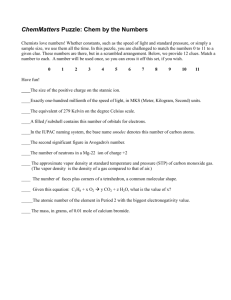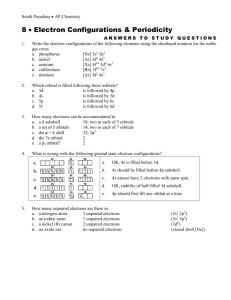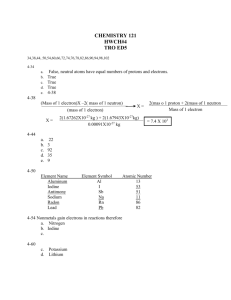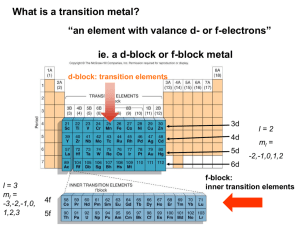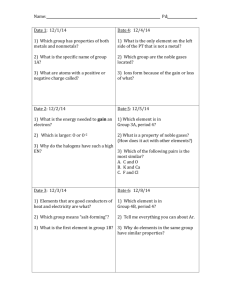Practice Problems
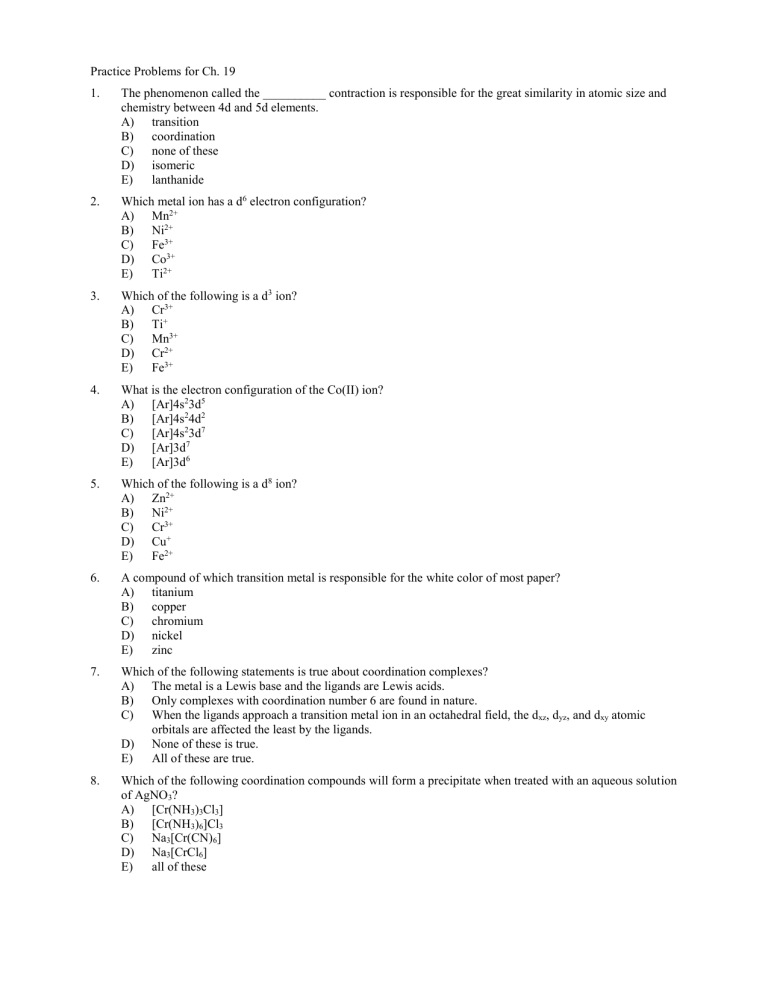
Practice Problems for Ch. 19
1. The phenomenon called the __________ contraction is responsible for the great similarity in atomic size and chemistry between 4d and 5d elements.
A) transition
B) coordination
C) none of these
D) isomeric
E) lanthanide
2. Which metal ion has a d 6 electron configuration?
A) Mn 2+
B) Ni 2+
C) Fe 3+
D) Co 3+
E) Ti 2+
3. Which of the following is a d 3 ion?
A) Cr 3+
B) Ti +
C) Mn 3+
D) Cr 2+
E) Fe 3+
4. What is the electron configuration of the Co(II) ion?
A) [Ar]4s 2 3d 5
B) [Ar]4s 2 4d 2
C) [Ar]4s 2 3d 7
D) [Ar]3d 7
E) [Ar]3d 6
5. Which of the following is a d 8 ion?
A) Zn 2+
B) Ni 2+
C) Cr 3+
D) Cu +
E) Fe 2+
6. A compound of which transition metal is responsible for the white color of most paper?
A) titanium
B) copper
C) chromium
D) nickel
E) zinc
7. Which of the following statements is true about coordination complexes?
A) The metal is a Lewis base and the ligands are Lewis acids.
B) Only complexes with coordination number 6 are found in nature.
C) When the ligands approach a transition metal ion in an octahedral field, the d xz
, d yz
, and d xy
atomic orbitals are affected the least by the ligands.
D) None of these is true.
E) All of these are true.
8. Which of the following coordination compounds will form a precipitate when treated with an aqueous solution of AgNO
3
?
A) [Cr(NH
3
)
3
Cl
3
]
B) [Cr(NH
3
)
6
]Cl
3
C) Na
3
[Cr(CN)
6
]
D) Na
3
[CrCl
6
]
E) all of these
9. How many d electrons are present on the metal ion in the complex ion PtCl
6
2– ?
A) 8
B) 6
C) 4
D) 3
E) 2
10. Which of the metal ions in the following complex ions has a d 5 electron configuration?
A) [V(H
2
O)
6
] 2+
B) [Ni(NH
3
)
6
] 3+
C) [Co(CN)
6
] 3–
D) [Fe(CN)
6
] 3–
E) [FeCl
6
] 4–
11. In which of the following complexes does the transition metal have a d 8 configuration?
A) [PdBr
4
] 2–
B) [Cu(H
2
O)
6
] 2+
C) [Ni(CO)
4
]
D) [Cd(NH
3
)
4
] 2+
E) [Fe(CN)
6
] 3–
12. A coordination compound of Cu 2+ can be described as Cu(NH
3
) x
SO
4
and is known to contain 29.9% NH
3
.
What is the value of x ?
A) 2
B) 3
C) 4
D) 6
E) none of these
13. _____ isomers and _______ isomers are classes of structural isomers.
A) Geometric, optical
B) Coordination, geometric
C) Linkage, geometric
D) Coordination, linkage
E) Geometric, linkage
14. Which of the following are structural isomers?
I. coordination isomers
II.
III. linkage isomers geometric isomers
IV. optical isomers
A) I, III
B) II, IV
C) I, III, IV
D) II, III
E) I, II
15. Which of the following complexes shows geometric isomerism?
A) [Co(NH
3
)
5
Cl]SO
4
B) [Co(NH
3
)
6
]Cl
3
C) [Co(NH
3
)
5
Cl]Cl
2
D) K[Co(NH
3
)
2
Cl
4
]
E) Na
3
[CoCl
6
]
16. How many of the following compounds exhibit geometric isomers?
I.
II.
III.
IV.
Pt(H
2
O)
2
Cl
2
(square planar)
[Co(H
2
O)
2
]Br
3
[Ni(H
2
O)
4
(NO
2
)
2
]
K
2
[CoCl
4
]
A) 0
B) 1
C) 2
D) 3
E) 4
17. Give the number of geometric isomers for the octahedral compound [Ma
2
B
2
C
2
], where A, B, and C represent ligands.
A) 1
B) 2
C) 3
D) 5
E) none of these
18. For the process Co(NH
3
)
5
Cl 2+ + Cl
–
Co(NH
3
)
4
Cl
2
+ + NH
3
, what would be the ratio of cis to trans isomers in the product?
A) 1:1
B) 1:2
C) 1:4
D) 4:1
E) 2:1
19. Which of the following statements about the complex ion Co(en)
2
Cl
2
+ is true?
(en = ethylenediamine, NH
2
CH
2
CH
2
NH
2
)
A) The complex ion contains Co(I).
B) The complex ion exhibits cis and trans geometric isomers, but no optical isomers.
C) The complex ion exhibits two geometric isomers ( cis and trans ) and two optical isomers.
D) Because en is a strong field ligand (large
), the complex ion is paramagnetic.
E) The geometric isomers of the complex ion have identical chemical properties.
20. The complex FeL
6
2+ , where L is a neutral ligand, is known to be diamagnetic. How many d electrons are there in this complex ion?
A) 4
B) 5
C) 6
D) 7
E) 8
21. Fluoride ion ranks low in the spectrochemical series and produces a weak crystal field in complex ions. Based on this information, predict the number of unpaired electrons in [MnF
6
] 3– .
A) 3
B) 1
C) 0
D) 2
E) 4
22. The complex ion [NiF
4
] 2– is tetrahedral. How many unpaired electrons are there in the complex?
A) 0
B) 1
C) 2
D) 3
E) 4
23. Which model(s) account(s) for the magnetism and color of coordination compounds?
I. the localized electron model
II. the crystal field model
A) I only
B) II only
C) both I and II
D) neither I nor II
24. A metal ion in a high-spin octahedral complex has two more unpaired electrons than the same ion does in a low-spin octahedral complex. Which of the following could the metal ion be?
A) Ti 2+
B) Cu 2+
C) Mn 2+
D) Co 3+
E) Co 2+
25. For which of the following metal ions would there be no distinction between low spin and high spin in octahedral complexes?
A) Cr 2+
B) V 2+
C) Co 3+
D) Mn 2+
E) Ni 3+
26. How many unpaired electrons are there in a complex ion having a d 5 electron configuration and an octahedral geometry in the weak-field case?
A) 1
B) 2
C) 3
D) 4
E) 5
27. The spectrochemical series is
I
–
< Br
–
< Cl
–
< F
–
< OH
–
< H
2
O < NH
3
< en < NO
2
–
< CN
–
Which of the following complexes will absorb visible radiation of the highest energy (shortest wavelength)?
A) [Co(H
2
O)
6
] 3+
B) [Co(I)
6
] 3–
C) [Co(OH)
6
] 3–
D) [Co(en)
3
] 3+
E) [Co(NH
3
)
6
] 3+
28. Which of the following statements is true of the crystal field model?
A) The interaction between metal ion and ligand is treated as a Lewis acid–base interaction.
B) The ligands are treated as negative point charges.
C) The metal ion–ligand bonds are considered completely ionic.
D) The electrons are assumed to be localized.
E) None of thee statements is true.
29. The color of a transition metal complex results from
A) bending vibrations.
B) stretching vibrations.
C) transition of an electron between d orbitals.
D) transition of an electron between an s orbital and a p orbital.
E) nuclear magnetic resonance.
30. A complex ion is a square planar complex. It has a d 8 electron configuration. What is the most reasonable d orbital scheme for this complex?
A)
B)
C)
D)
E)
31. Which of the following complexes would be diamagnetic?
A) [Ni(CN)
6
] 4–
B) [V(CN)
6
] 3–
C) [Co(CN)
6
] 3–
D) [Cr(CN)
6
] 3–
32. How many unpaired electrons are there in the complex ion [Co(NO
3
)
6
] 4– ? For this ion, the nitrate ligands produce a very strong crystal field.
A) 1
B) 2
C) 3
D) 4
E) 5
33. How many unpaired electrons are found in NiBr
4
2– (tetrahedral)?
A) 0
B) 1
C) 2
D) 4
E) 5
34. How many unpaired electrons are found in [MnCl
6
] 3– (weak field)?
A) 0
B) 1
C) 2
D) 4
E) 5
35. How many unpaired electrons are found in Fe(en)
3
2+ (strong field)?
A) 0
B) 1
C) 2
D) 4
E) 5
36. How many unpaired electrons are found in Mn(NH
3
)
4
3+ (tetrahedral)?
A) 0
B) 1
C) 2
D) 4
E) 5
37. How many unpaired electrons are found in Zn(H
2
O)
6
2+ ?
A) 0
B) 1
C) 2
D) 4
E) 5
38. How many unpaired electrons are found in [Co(CN)
4
] 3– (square planar)?
A) 0
B) 1
C) 2
D) 4
E) 5
39. How many unpaired electrons are found in MnCl
4
2– (tetrahedral)?
A) 0
B) 1
C) 2
D) 4
E) 5
40. How many unpaired electrons are found in Mn(CN)
6
3– (strong field)?
A) 0
B) 1
C) 2
D) 4
E) 5
41. Which of the following is paramagnetic?
A) [Zn(H
2
O)
6
] 2+
B) [Co(NH
C) [Cu(en)
3
)
6
] 3+ (strong field)
3
] +
D) [Mn(en)
3
] 2+ (strong field)
E) [Fe(en)
3
] 2+ (strong field)
42. The complex ions of Zn 2+ are all colorless. The most likely explanation for this is that
A) Zn 2+ is paramagnetic.
B) Zn 2+ exhibits "d orbital" splittings in its complexes such that they absorb all wavelengths in the visible region.
C) because Zn 2+ is a d 10 ion, it does not absorb visible light even though the "d orbital" splittings are correct for absorbing visible wavelengths.
D) Zn 2+ is not a transition metal ion.
E) None of these explanations could be correct.
43. Which of the following crystal field diagrams is correct for Co(CN)
6
4– , where CN
–
is a strong-field ligand?
A)
B)
C)
D)
E) none of these
44. Which of the following crystal field diagrams is correct for Mn(CN)
6
3– , where CN
–
is a strong-field ligand?
A)
B)
C)
D)
E) none of these
45. Specify the number of unpaired electrons in [NiCl
6
] 4– .
A) 2
B) 3
C) 0
D) 4
E) 5
46. Specify the number of unpaired electrons in [Ni(NH
3
)
6
] 2+ (strong field).
A) 0
B) 4
C) 2
D) 6
E) 5
47. Specify the number of unpaired electrons in NiCl
4
2– (tetrahedral).
A) 0
B) 1
C) 2
D) 4
E) 5
48. Specify the number of unpaired electrons in CoF
6
3– (weak field).
A) 0
B) 1
C) 2
D) 4
E) 5
49. Specify the number of unpaired electrons in Co(en)
3
3+ (strong field).
A) 0
B) 1
C) 2
D) 4
E) 5
50. Specify the number of unpaired electrons in [Mn(H
2
O)
4
] 3+ (tetrahedral).
A) 0
B) 2
C) 1
D) 4
E) 5
51. According to crystal field theory, how many unpaired electrons are present in the complex ion [Zn(H
2
O)
6
] 2+ ?
A) 0
B) 1
C) 2
D) 3
E) 4
52. The complex ion Fe(CN)
6
4– (no unpaired electrons) is classified as
A) weak field.
B) strong field.
C) There is no way to tell.
53. The complex ion Co(NH
3
)
6
2+ (three unpaired electrons) is classified as
A) weak field.
B) strong field.
C) There is no way to tell.
54. The complex ion Ni(NH
3
)
6
2+ (two unpaired electrons) is classified as
A) weak field.
B) strong field.
C) There is no way to tell.
55. How many unpaired electrons are there in Ir(Br)
6
4– ? (Br
–
is a weak-field ligand.)
A) 4
B) 3
C) 2
D) 1
E) 0
56. Which of the following statements is true about the octahedral complexes of Ni 2+ ?
A) Both strong- and weak-field complexes are diamagnetic.
B) The strong-field complex is diamagnetic and the weak-field complex is paramagnetic.
C) The strong-field complex is paramagnetic and the weak-field complex is diamagnetic.
D) Both strong- and weak-field complexes are paramagnetic.
57. This molecule is toxic because it has about 200 times the affinity for the Fe 2+ in hemoglobin that oxygen does, causing asphyxiation if enough of it is present in the air.
A) CN
–
B) CO
C) CO
2
D) NH
3
E) CH
4
58. Carboxyhemoglobin is formed when __________ prevents the normal uptake of oxygen in the blood.
A) CN
–
B) CO
C) CO
2
D) NH
3
E) CH
4
59. Which of the following ligands are capable of linkage isomerism?
N
3
–
, NO
2
–
, NH
3
, NH
2
CH
2
CH
2
NH
2
, OCN
–
, Cl
–
, H
2
O , SCN
–
Use the following to answer questions 60-64:
Here are some crystal field representations of d electrons in an octahedral field:
Choose the representation that fits the transition metal atom in the following species.
60. Fe(OH
2
)
6
3+ (assume weak field)
61. [Co(NH
3
)
4
Br
2
] +
62. K
4
Mn(CN)
6
(assume strong field)
63. K
4
Fe(CN)
6
64. [Cr(NH
3
)
5
Cl]SO
4
ANSWERS
.
1. E 11. A 21. E 31. C 41. D 51. A 61. B
2. D 12. C 22. C 32. A 42. C 52. B 62. D
3. A 13. D 23. B 33. C 43. B 53. A 63. B
4. D 14. E 24. E 34. D 44. A 54. C 64. A
5. B 15. D 25. B 35. A 45. A 55. B
6. A 16. C 26. E 36. D 46. C 56. D
7. C 17. D 27. D 37. A 47. C 57. B
8. B 18. D 28. B 38. A 48. D 58. B
9. B 19. C 29. C 39. E 49. A 59. **
10. D 20. C 30. D 40. C 50. D 60. C
** 59. NO
2
, OCN , SCN -
